TRANSPORTATION IN ANIMALS AND PLANTS for Class 7 SCIENCE
INTRODUCTION
Hamare chapter ka name hai ”Transportation in animals and plants”, toh iss chapter mein hum things ke transportation ke baare mein padhenge. Jaisa ki hum jante hai har ek living organism ko food, water aur minerals ki jarurat hoti hai toh iss chapter mein hum janege ki plants aur animals kaise yeh food, water and minerals lete hai aur kaise inko poori body mein transport karte hai. Substances ke iss transportation channel ko hum circulatory system kehte hai. Iss chapter mein hum excretion ke baare mein bhi janege. Iska matlab hai ki hum jaan payenge ki food ke utilisation ke bad jo waste product bachta hai uska removal kaise kiya jata hai. Toh iss chapter mein hum plants aur animals mein substances ke transportation aur excretion ke baare mein padhenge.
Circulatory System
Body ka woh transport system jo body mein sabhi materials ko transport karta hai usko circulatory system kehte hai. Circulatory system mein blood, blood vessels aur heart included hai. Sabse pehle hum blood ke baare mein padhenge.
Blood
Blood Vessels
Jaisa ki hamne padha ki blood vessels ek tubes ka network hota hai jo hamari body mein blood carry karti hai. Yeh heart aur baki body parts ke beech mein present hoti hai. Hamari body mein three types ki blood vessels present hoti hai- arteries, veins and capillaries.Arteries- Yeh oxygen rich blood ko heart se sabhi body parts mein lekar jati hai. Lekin pulmonary artery ek aisi artery hai jo carbon dioxide rich blood ko lungs mein lekar jati hai. Heart inme blood pump karta hai aur Inki thick elastic walls hoti hai taki yeh blood ke pressure ko tolerate kar sake. Yeh deep down the skin lie karti hai isliye easily dekhi nahi ja sakti.
Veins- Yeh carbon dioxide rich blood ko poori body se wapas heart mein lekar aati hai. Lekin pulmonary vein ek aisi vein hai jo oxygen rich blood ko lungs se heart mein lekar jati hai. Yeh just skin ke neeche present hoti hai isliye easily dikh jati hai. Yeh skin ke neeche greenish-blue lines ki tarah najar aati hai. Inki walls thin hoti hai aur inme valves bhi present hote hai jo blood ke backflow ko prevent karte hai aur sirf heart ki taraf flow karvate hai.
Capillaries- Yeh bahut thin blood vessels hoti hai jo arteries ko veins se connect karti hai. Arteries smaller vessels mein divide hoti hai jinko hum capillaries kehte hai aur yeh further join ho kar veins form karti hai jo heart tak blood lekar jati hai.
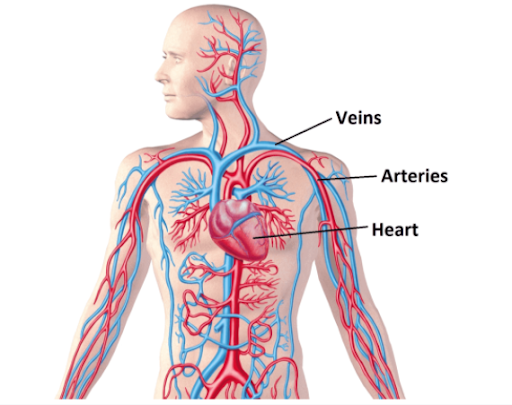
Pulse rate
Hamari pulse per minute jitne times beat karti hai usko pulse rate kehte hai.
Lekin pulse hoti kya hai?
Jab hum apne right hand ki middle aur index finger ko left wrist ke inner side par rakhte hai toh arteries ke blood flow ki wajah se hum kuchh throbbing movements feel karte hai, inn movements ko hi pulse kehte hai.
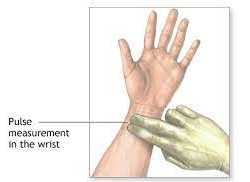
Normally ek resting person ka pulse rate 72 to 80 beats per minute hota hai.
Ab hum janege ki heart kya hota hai, yeh kaise function karta hai.
Heart
Heart ek organ hai jo continuously beat karta hai aur hamari body mein blood ko transport karne ke liye pump ki tarah act karta hai. Blood apne sath aur bhi substances carry karta hai. Yeh non-stop poori life blood ko pump karta hai. Heart chest cavity mein slightly lower side par present hota hai. Yeh roughly hamari fist ke size ka hota hai. Heart ek special type ke muscles se bana hota hai jisko hum cardiac muscles kehte hai.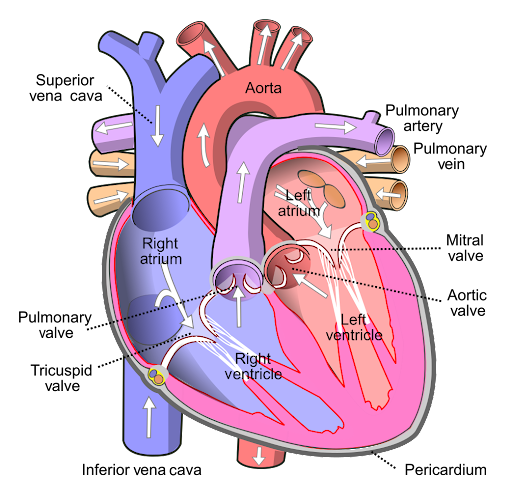
Structure of Heart
Heart four compartments mein divided hota hai jinko hum chambers kehte hai.
Lekin aapne socha hai ki yeh partition kyo hota hai?
Heart mein oxygenated aur deoxygenated dono type ka blood present hota hai aur inko separate rakhne ke liye hamara heart chambers mein divided hota hai. Upper two chambers ko hum atria kehte hai aur lower two chambers ko hum ventricles kehte hai. Yeh atria aur ventricles valves se separated hote hai. Yeh valves muscular flaps hote hai jo blood ko sirf ek hi direction mein flow karne ke liye allow karte hai aur blood ka backflow prevent karte hai.
Ab heart ke chambers ke baare mein toh hamne jaan lia lekin heart ka ek aur partition bhi hota hai, left aur right partition. Heart ke right side mein deoxygenated blood hota hai aur left side mein oxygenated blood hota hai. Yeh dono parts ek partition se separate hote hai jisko hum septum kehte hai. Yeh dono hi sides separate pumps ki tarah work karti hai, left side oxygenated blood ko poori body mein pump karti hai aur right side deoxygenated blood ko lungs mein lekar jati hai. Inn dono type ke blood ko separate rakhna isliye important hai taki cells ke paas proper amount mein oxygen pahunch sake aur woh properly respiration karke energy release kar sake.
Niche figure mein hum dekh sakte hai ki blood heart ke right side se flow karna start karta hai aur arrows ki help se hum dekh sakte hai ki yeh kaise flow karta hai.
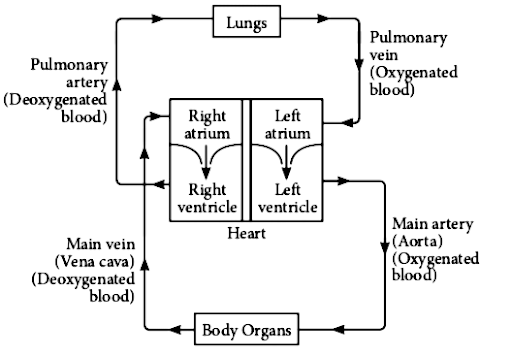
Heartbeat
Heart ki muscles rhythmically contract aur relax karti hai aur ek lubb-dubb ki specific sound produce karti hai, iss sound ko hi hum heartbeat kehte hai. Ek contraction aur ek relaxation se milkar ek heartbeat banti hai. Yeh heartbeat poori lifetime chalti rehti hai. Hum apni chest ke left side par hand place karke heartbeat ko feel bhi kar sakte hai. Doctor’s stethoscope ki help se hamari heartbeat sunte hai. Ek normal human heart one minute mein 72 to 80 times beat karta hai. Heartbeat aur pulse rate dono ek doosre se connected hai. Ek heartbeat ek pulse generate karti hai aur hamara pulse rate hamari heartbeat ko indicate karta hai.
Stethoscope- Yeh ek device hota hai jo heart ki sound ko amplify karta hai. Isme ek chest piece hota hai, two ear piece hote hai aur ek tube hoti hai jo inn dono parts ko join karti hai.
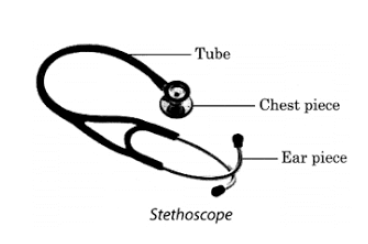
Sponges and Hydra- Sponges aur hydra mein koi circulatory system present nahi hota, inme water ke through hi saari chijo ka circulation hota hai aur water ke through hi waste material excrete hota hai.
Excretion In Animals
Ek aisa process jisme living organisms ke cells mein produced waste ko remove kiya jata hai usko excretion kehte hai.
Jo parts excretion ke process mein involve hote hai usko excretory system kehte hai.
Lekin excretion kyo hota hai?
Jab bhi hamari body kuchh (food, water, etc.) use karti hai toh yeh kuchh by-products produce karti hai jisko hum waste material kehte hai. Yeh waste material poisonous ho sakte hai isliye inko body se remove karna bahut important hota hai jiske liye hamari body excretion ka process perform karti hai. Ab hum humans ke excretory system ke baare mein padhte hai.
Excretory system in humans
Humans mein excretory system different organs include hote hai- a pair of kidneys, a pair of ureters, a urinary bladder and a urethra.Hamari body mein urea major waste product release hota hai. Yeh ek toxic substance hota hai jisko body se remove karna important hota hai. Kidney blood mein se urea ko remove karti hai. Kidney hamari body ka main excretory organ hai. Urea aur unwanted salts water mein dissolve karke yellowish liquid banate hai jisko hum urine kehte hai. Blood ko filter karne ke liye kidneys ka use kiya jata hai. Kidneys mein blood capillaries present hoti hai jo blood ko filter karti hai. Mixed blood dono kidneys mein jata hai, waha useful substances wapas blood mein absorb ho jate hai aur waste urine ki tarah remove ho jate hai. Urine yaha se ureters ke through urinary bladder mein jata hai.
Urinary bladder mein yeh kuchh der ke liye store rehta hai aur fir muscular tube ke end mein jo urinary opening (urethra) hoti hai, uske through pass ho jata hai.
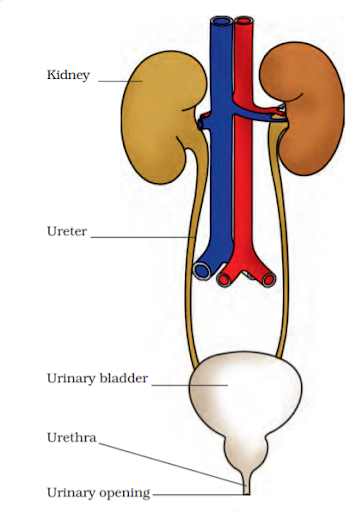
Ek adult human being normally 24 hours mein 1-1.18 L urine pass karte hai. Urine mein 95% water, 2.5% urea aur 2.5% other waste products hote hai.
Hamari body se iske alawa bhi waste products produce hote hai aur woh different processes se release ho jate hai. Eg- Carbon dioxide hamare lungs se exhalation ke time par remove hoti hai, excess water aur salts hamari body se sweat ki form mein release ho jate hai.
Summers mein hamein bahut sweating hoti hai, yeh sweat fir evaporate ho jata hai jisse hamari body ko cool feel hota hai.
Humans ki tarah doosre animals bhi different ways se apni body se waste excrete karte hai. Yeh ways unki body mein present water ki availability par depend karte hai. Eg- aquatic animals apni body se cell waste ko ammonia ki form mein release karte hai jo directly water mein dissolve ho jata hai; land animals jaise birds, lizards, snakes, etc. semi-solid white coloured compound release karte hai.
Dialysis- Agar kisi person ki kidneys kisi infection ya kisi injury ki wajah se work karna band kar deti hai toh uske blood ko ek artificial kidney jaisi machine se filter kiya jata hai, iss process ko dialysis kehte hai.
Transport Of Substances In Plants
Hum jante hai ki plants roots ke through water aur minerals soil se lete hai aur leaves ke paas transport kar dete hai. Leaves bhi photosynthesis ki process se food prepare karte hai aur usko plant ke baaki parts mein transport karte hai. Iss topic mein hum aage padhenge ki yeh water, minerals aur food ka transport kaise hota hai.
Transport of water and minerals
Plant roots soil mein se water aur minerals absorb karti hai. Roots mein root hairs hote hai jo absorption ke liye roots ka surface area increase karte hai. Root hair soil mein present water ke contact mein rehte hai aur usme se water aur minerals absorb karte hai. Plants mein pipe-like vessels present hoti hai jo water and minerals transport karte hai. Yeh vessels special cells se mil kar bani hoti hai aur cells mil kar vascular tissue banate hai. Yeh tissues mil kar special function perform karte hai. Plants mein xylem ek vascular tissue hota hai jo roots ko leaves se connect karta hai aur poore plant ko water transport karta hai.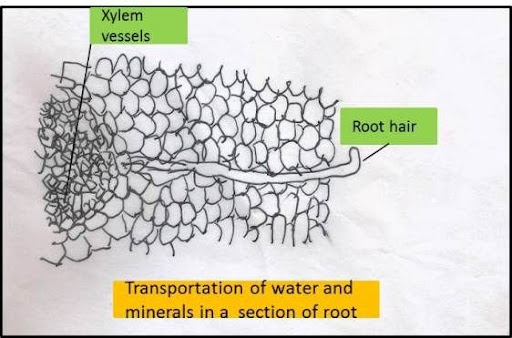
Leaves food synthesise karti hai aur ek aur vascular tissue phloem isko poore plant mein transport karta hai.
Xylem aur phloem dono mil kar vascular tissues or conducting tissues banate hai.
Transpiration
Plants transpiration ke process se bahut sara water release karte hai aur plants ko cool karte hai. Plants jo bhi water aur minerals soil se absorb karte hai woh sara utilise nahi karte, excess water ko woh stomata ke through release kar dete hai aur yeh water evaporate ho jata hai. Iss process ko hum transpiration kehte hai. Evaporation ki wajah se leaves men suction pull create ho jata hai jiski wajah se water upward move karta hai aur trees ke upper parts tak pahunch jata hai.POINT 1
Blood: Blood is a fluid tissue that transports nutrients and oxygen to the cells and carries away carbon dioxide and other waste products in our body.
Artery: Arteries are blood vessels that carry oxygenated blood to the cells and tissues of our body.
Blood vessels: Blood vessels are tubes that carry blood all over the body.
Capillaries: Capillaries are the smallest of the body’s blood vessels.
Veins: Veins are blood vessels that carry away deoxygenated blood from the cells and tissues of our body.
Heart: The heart is a muscular organ in animals that pumps blood through blood vessels to all the parts of the body.
Dialysis: Dialysis is the filtering of blood outside the human body using a machine, when both the kidneys fail.
Excretion: The process of removal of waste products from the cells of living organisms is called excretion.
Tissue: Tissue is a group of cells that have similar structure and that function together as a unit.
Transpiration: Transpiration is the loss of water in the form of water vapour from stomata present on leaves.
SUMMARY
1. In most animals the blood that circulates in the body distributes food and oxygen to different cells of the body. It also carries waste products from different parts of the body for excretion.
2. Circulatory system consists of the heart and blood vessels.
3. In humans, blood flows through arteries and veins and the heart acts as a pumping organ.
4. Blood consists of plasma, RBC, WBC and platelets. Blood is red due to the presence of a red pigment, haemoglobin.
5. The human heart beats about 70–80 times per minute in an adult person. This is called heart rate.
6. Arteries carry blood from the heart to all parts of the body.
7. Veins carry blood from all parts of the body back to the heart.
8. Removal of waste products from the body is called excretion.
9. Excretory system of humans consists of two kidneys, two ureters, a urinary bladder, and urethra.
10. Salts and urea are removed along with water as sweat.
11. Fish excrete waste substances such as ammonia which directly dissolve in water.
12. Birds, insects and lizard excrete uric acid in semi-solid form.
13. Water and mineral nutrients are absorbed by roots from the soil.
14. Nutrients are transported along with water to the entire plant via the vascular tissue called xylem.
15. The vascular tissue for the transport of food to the various parts of the plant is phloem.
16. A lot of water is lost by plants in the form of vapour through stomata during transpiration.
17. Transpiration generates a force which pulls up water absorbed by the roots from the soil, to reach the stem and leaves.